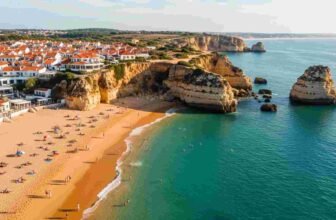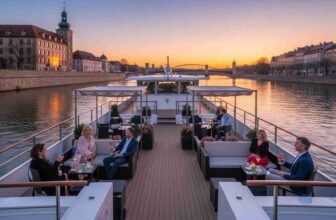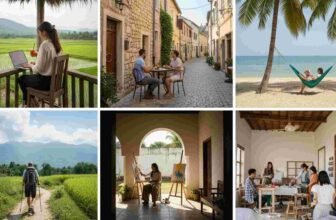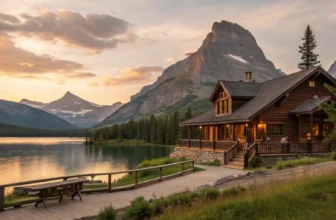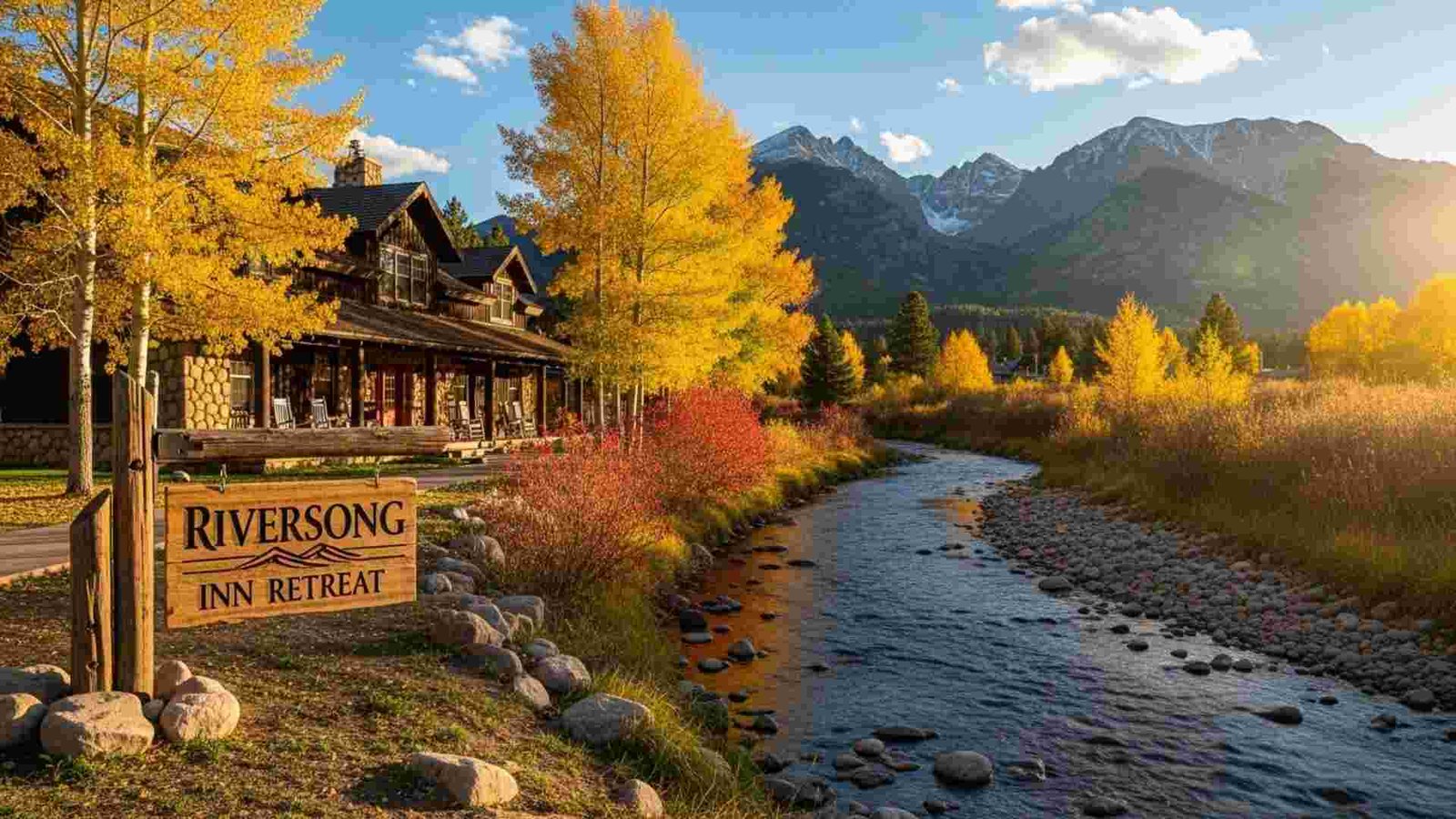

Warm bread scent drifts from a corner bakery as a bell rings and the sidewalk hums with neighborly gossip. If your compass has been set to airports and algorithms, this is your nudge to turn inward: toward places where time slows, stories deepen, and doors hold for you.
In a season of crowded headlines and crowded coasts, these main streets offer wonder you can touch—hand-lettered signs, porchlight festivals, stargazing walks home. Here, detours become rituals and small talk becomes belonging. Follow along for a map of sixteen honest escapes—when to go, how to savor, and the moments worth staying for.
1. Franklin, Tennessee

Franklin, Tennessee. This one feels like stepping back in time—but with all the modern comforts you want. With a 2025 population estimated around 90,388 people (up from ~84,155 in 2020). Despite that growth, downtown Franklin retains its historic charm, with lots of protected older buildings in the core.
Walking down its main street, you’ll see an impressive blend of past + present. Franklin was the site of a major 1864 Civil War battle (the Second Battle of Franklin) and some of the buildings from that era remain. You’ll also find boutique shops, modern cafés, and festival events that draw crowds without feeling overrun. For example, the “Dickens of a Christmas” event brings costumed volunteers in the Victorian-style square.
Practical Information:
- Peak / off-peak seasons & weather: Being in Middle Tennessee, spring (April–May) and fall (September–October) are especially pleasant—mild temps, fewer chances of sticky summer humidity. Winters can be chilly but not extreme.
- Ideal duration of visit: For a main-street experience plus nearby sightseeing, 1½ to 2 days works well. Stay the first night downtown, explore historic sites and shops, then next day head out a little beyond town for nature or adjacent neighbourhoods.
- Must-try local experiences: Visit the historic Carnton or Lotz houses to get the Civil War story; enjoy a stroll or bike ride around the Harpeth River corridor; attend a local festival if the timing matches (e.g., “Main Street Festival” or other community events).
- Budget considerations: Since it’s near a metro area (Nashville), lodging options vary from premium to moderate. Staying right in downtown historic area may cost more. Eating and shopping in the historic core may skew a little upscale.
- Cultural etiquette tips: It’s a friendly southern town: greetings, manners, modest dress when visiting historic homes or churches. If you pop into small boutiques, take a moment to ask about the building’s history—locals appreciate that interest.
- Photography opportunities: The historic downtown square, Victorian-era buildings, river-front views, and early morning or golden-hour shots of the shopfronts all deliver. Also look for evening lights on Main Street and autumn foliage if visiting fall.
2. Galena, Illinois
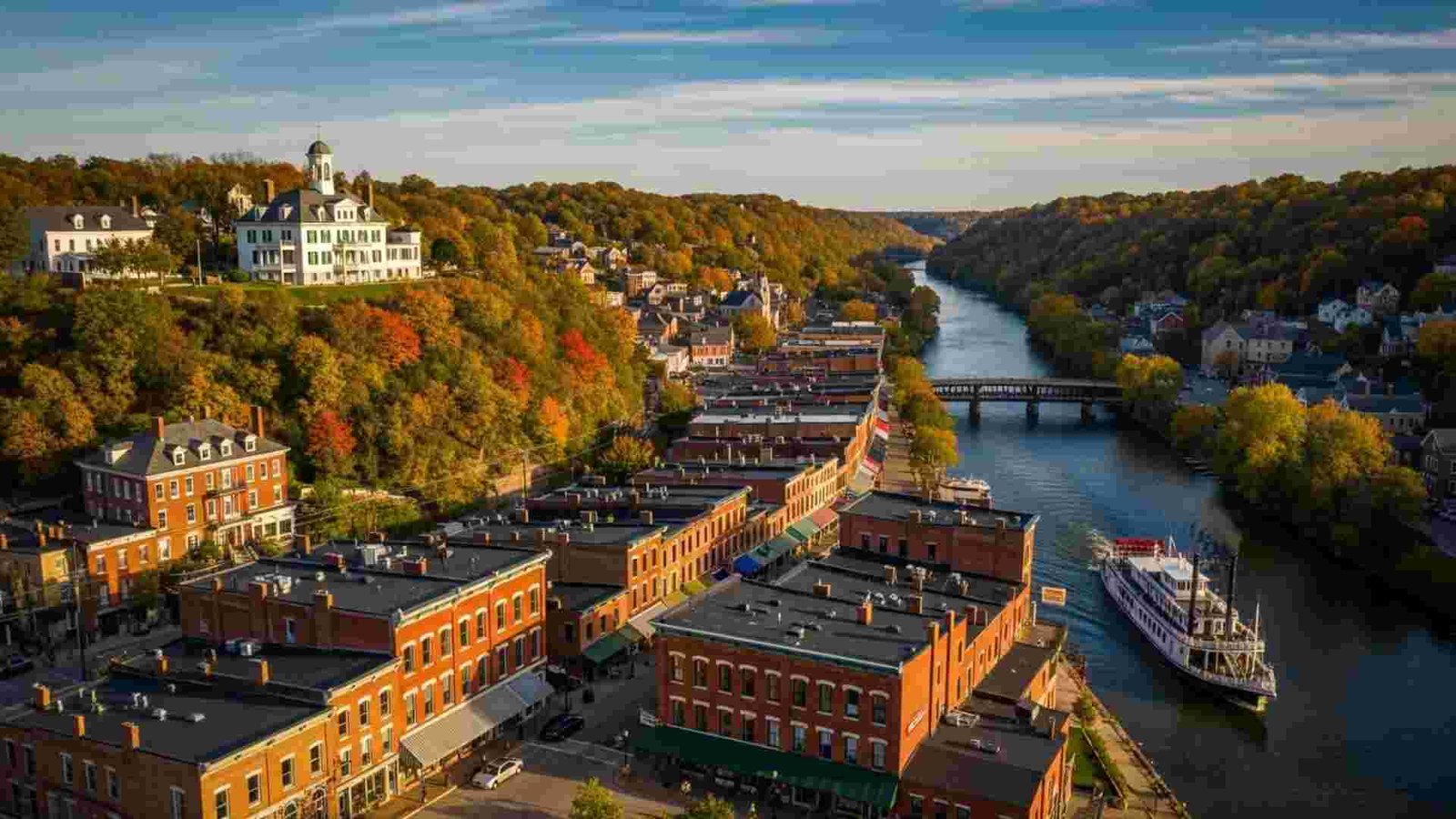
Galena is a gem. Located in northwest Illinois, this small town rides its historic lead-mining and 19th-century boom legacy into the present with a charming streetscape and strong visitor credentials. Nearly $554 million in tourism economic impact was reported for the region in 2025, with over 3,000 jobs supported. And its Airbnb data: average stay ~2.9 nights, average spend ~$630 for 2.9 nights, average nightly ~$210.
When you walk Galena’s Main Street, you’ll find red-brick buildings, antiquing shops, galleries, vineyards nearby, and the rolling hills of the Mississippi Valley around you. That gives a nice combo of history + scenic nature. The lodging occupancy rates are also rising—reflecting how the town is doing well as a destination.
Practical Information:
- Peak / off-peak seasons & weather: Peak is typically summer (June–Aug) and fall (Sept), when the hills look spectacular. Off-peak is winter—cold, snowy—if you’re fine with that.
- Best ways to reach & explore: Galena is somewhat remote—so driving is best. Rent a car and aim for 2–3 nights to really soak it in. Downtown is compact and walkable once you’re there.
- Ideal duration of visit: 2–3 days gives enough time to explore Main Street, take in nearby vineyards or historic homes, maybe a day trip into countryside.
- Must-try local experiences: Browse antique shops and local art galleries; take a wine-tasting tour in Jo Daviess County vineyards; climb up to scenic overlooks for valley views; join a walking historic tour.
- Budget considerations: Because it’s a desirable small-town escape, lodging can tick up in price during peak. If you go off-peak you may find deals. Dining is moderate but you’ll find richer experiences in the town centre.
- Cultural etiquette tips: It’s a small community with local pride in its history. Ask questions about the historic buildings, and be mindful of quiet hours if staying near residential parts.
3. Fredericksburg, Texas
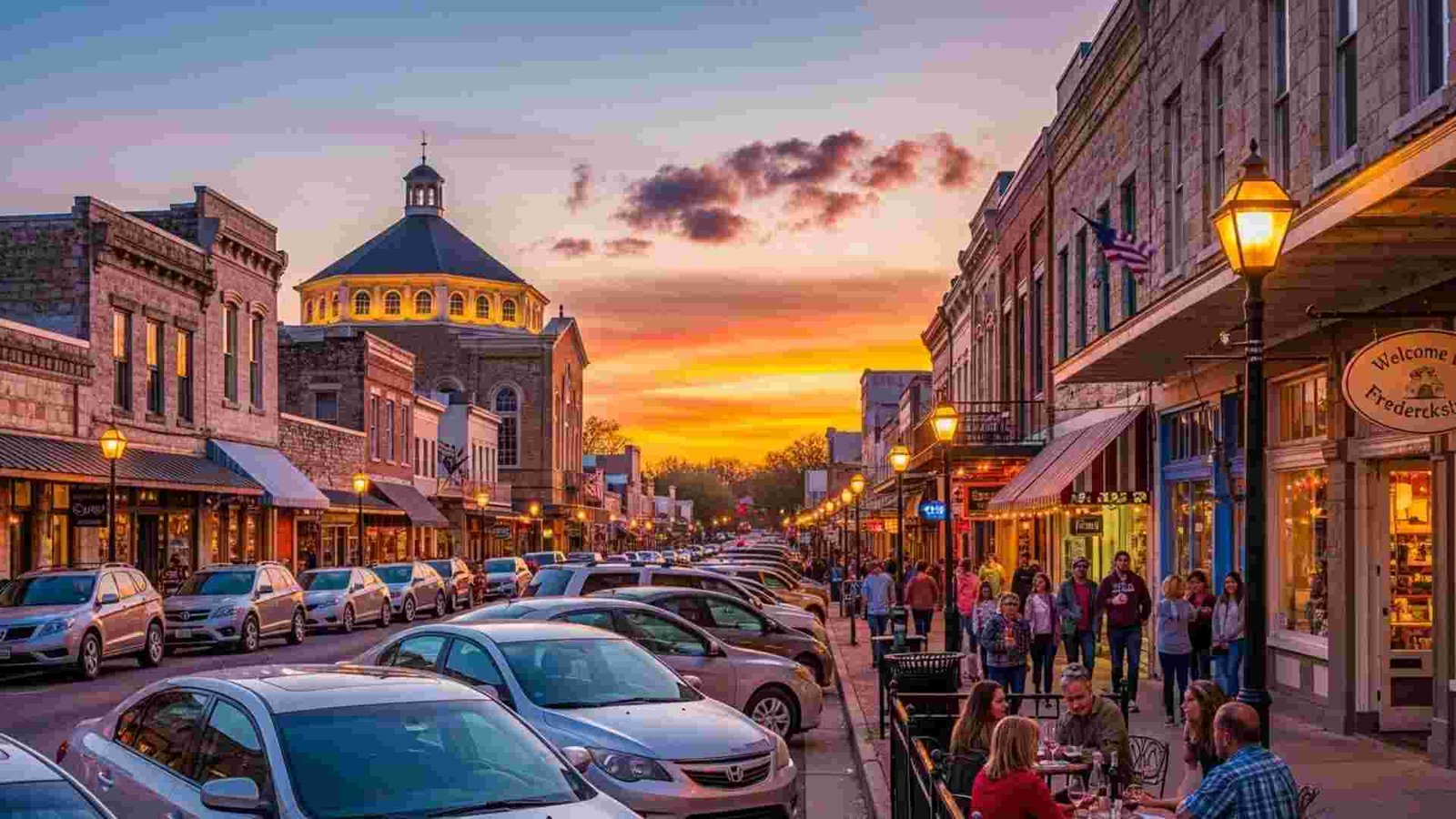
Fredericksburg sits in Texas Hill Country and brings both historic German-Texan heritage and wine country appeal. It’s small (population ~11,889 in 2025) but punches above its size in terms of attraction—somewhere between 1.5 million to 2 million visitors annually.
The town bans large chain stores on Main Street (as of 2025) to preserve that local-business, independent-shop feel. You’ll find over 75 wineries in the region (one source puts over 80) and a strong day-trip vibe from Austin or San Antonio. The German heritage is visible in the architecture, food, strolling down the “Marktplatz” feel, and the surrounding Hill Country’s scenic drives.
Practical Information:
- Peak / off-peak seasons & weather: Spring and fall are ideal; summers can get hot (and crowds may increase). Winter is mild and quieter.
- Best ways to reach & explore: Drive in from Austin (~1.5 h) or San Antonio. Stay 2 nights to explore Main Street, wineries, and surrounding countryside. A day trip works but you’ll feel rushed.
- Ideal duration of visit: 2–3 days gives you time to enjoy Main Street, a winery tour, maybe a nature hike or nearby Enchanted Rock if up for it.
- Must-try local experiences: Browse Main Street’s German-heritage shops; sample wine at local vineyards; join a food or wine festival if timing matches; explore the Hill Country landscapes.
- Budget considerations: Because of its rising popularity, lodging especially on or near Main Street can be fairly premium. Dining and tasting rooms can add up, so plan ahead if on a tighter budget.
- Cultural etiquette tips: Respect the heritage and local businesses. During tastings, ask the vintners about their history. On Main Street, supporting small shops makes a difference to the local character.
4. Stowe, Vermont

Stowe is quintessential New England charm with a small-town main street, village rhythm, and mountain backdrop. The 2020 U.S. Census recorded population of ~5,223. It’s also been named Vermont’s best small town to visit (2025) by sources such as WorldAtlas.
The village is nestled at the foot of Mount Mansfield, Vermont’s highest peak, and the terrain gives you both outdoor adventure and historic village ambiance. The town’s 2024 annual report emphasises its commitment to “protect and enhance its scenic resources” and maintain the “unique context, scale and visual patterns that define the landscape.”
Practical Information:
- Peak / off-peak seasons & weather: Fall (September–October) for foliage and crisp air; winter for skiing (if you’re into that); summer is quieter, green and pleasant. Spring can be soggy.
- Best ways to reach & explore: You’ll likely drive in (e.g., from Burlington or Boston area) or fly into Burlington and rent a car. Staying a night gives you more relaxed time.
- Ideal duration of visit: 2–3 days minimum to enjoy the village, take a scenic trail, maybe a mountain ride or gondola (if open), and stroll main street.
- Must-try local experiences: Walk the historic village streets, visit local independent bookshops and Maple-syrup themed stores, hike or mountain-bike up paths off Mt. Mansfield, or simply sip coffee in a cozy café while watching people.
- Budget considerations: Lodging in resort towns can be pricey in peak seasons (fall foliage, winter ski). Off-peak offers better value. Dining tends toward mid-to-upscale independent spots.
- Cultural etiquette tips: In such a small community, shop locally, tip well, and treat the nature respectfully—stick to trails, respect “quiet hours” if lodging.
- Photography opportunities: Classic white-steepled churches, Main Street storefronts with fall colours, mountain vistas, snow-covered peaks in winter—ideal for postcards.
5. Beaufort, South Carolina

Beaufort, South Carolina. Although it’s coastal, it still carries that “small-town main street” feel with strong authenticity. Founded in 1711 (the second-oldest city in SC). Its downtown — a full 304-acre National Historic Landmark District.
Beaufort blends historic architecture (Federal, Greek Revival, Victorian and more) with waterside charm. The town draws nearly 2 million visitors a year to Beaufort & the Sea Islands region. It feels alive but relaxed—great for a getaway where you soak in history, architecture, Lowcountry culture, marsh views and easy strolls.
Practical Information:
- Peak / off-peak seasons & weather: Spring (March–May) and fall (Sept–Nov) tend to be optimal—pleasant weather, fewer bugs. Summers are hotter and more humid; hurricane-season awareness wise.
- Best ways to reach & explore: Fly into Savannah or Charleston then drive; downtown Beaufort is very walkable with historic streets. Take a boat or marsh tour to see another dimension.
- Ideal duration of visit: 1½ to 2 days is doable for downtown and immediate surroundings; 3 days if you include Sea Islands or nearby nature.
- Must-try local experiences: Walk or cycle along Bay Street and the waterfront; visit antebellum homes and historic district; try Lowcountry cuisine (think shrimp & grits, oysters); take a marsh or boat tour; catch a sunset over the intracoastal.
- Budget considerations: Lodging in historic homes or boutique inns will cost more; motels slightly farther out offer lower rates. Dining ranges from casual to fine—budget according to your style.
- Cultural etiquette tips: Respect the heritage and the residential nature of many downtown areas. If you venture into Sea Islands, be aware of private land/resident zones and local culture.
- Photography opportunities: Live-oak canopies with Spanish moss, pastel historic homes, sunset over the Beaufort River, boat reflections in the marsh—rich visual content.
6. Leavenworth, Washington
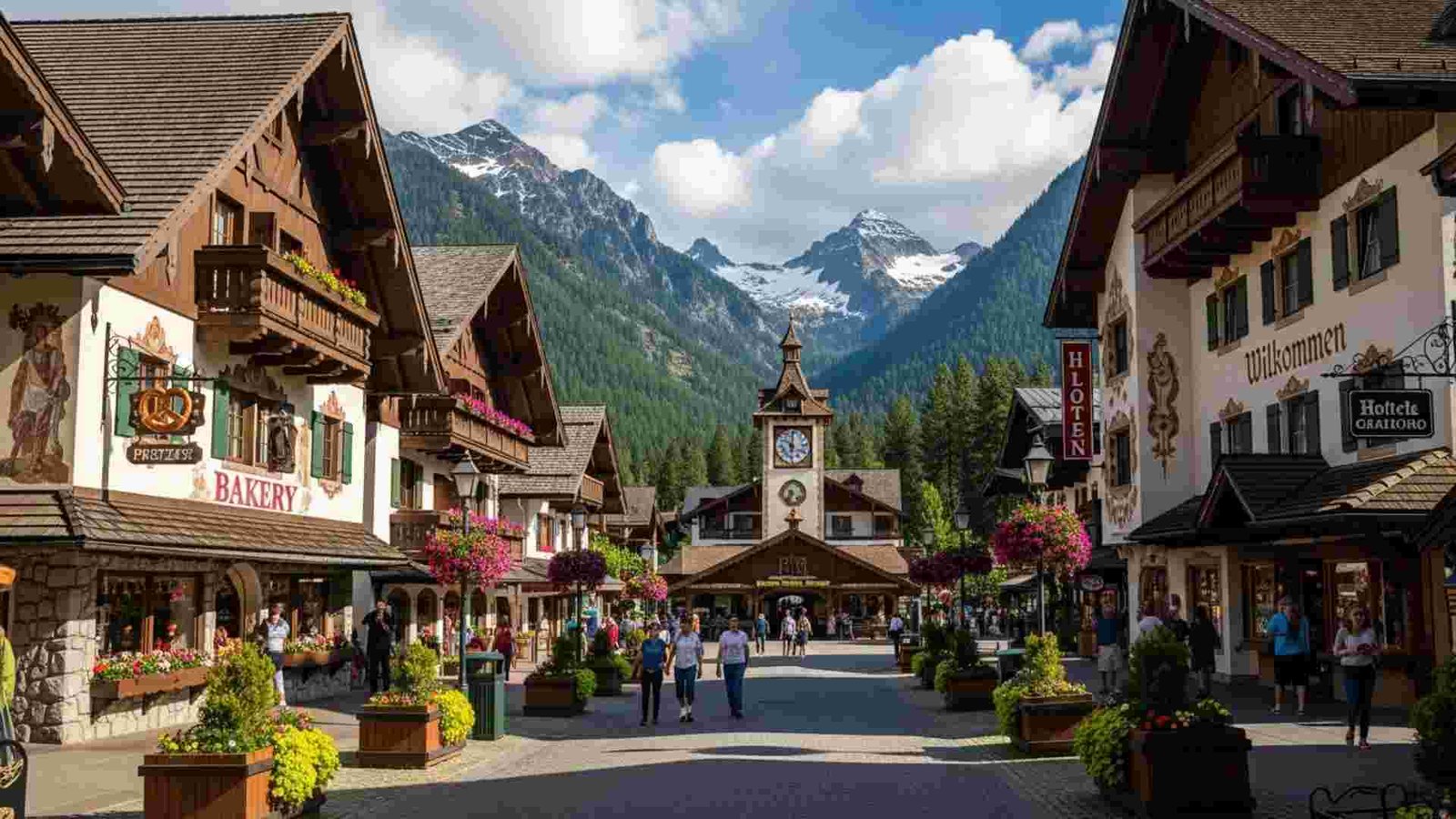
Think storybook Alps, tucked into the Cascades. Timbered facades, bratwurst on the breeze, and mountains shouldering the skyline. What really sets it apart is scale: roughly 3 million visitors a year now pour in for outdoor fun and the lights-on-snow glow of Christmastown (over half a million lights from Thanksgiving into February). It’s kitschy, sure—and completely irresistible when the first flakes land.
Here’s the lesser-known layer: a quirky Nutcracker Museum (go on the scavenger hunt), blue-hour strolls when day-trippers leave, and shoulder-season hikes in the Icicle corridor when larches turn gold. If your perfect moment is crisp air + glühwein + a brass band warming up under the marquee, this is it.
Practical Information:
- Peak Season: December (Christmas Lighting Festival) and July–August (hiking season).
- Off-Peak: April–May and October — fewer crowds, cheaper lodging.
- Getting There: Drive from Seattle (about 2.5 hours via US-2).
- Ideal Stay: 2 nights to explore the town and surrounding trails.
- Must-Try: Bratwurst from München Haus, local cider flights, and the Nutcracker Museum.
- Budget Tip: Midweek stays can save 25–30 % on rooms.
- Photography: Golden hour on Front Street, snow-covered rooftops, and river reflections.
7. Eureka Springs, Arkansas
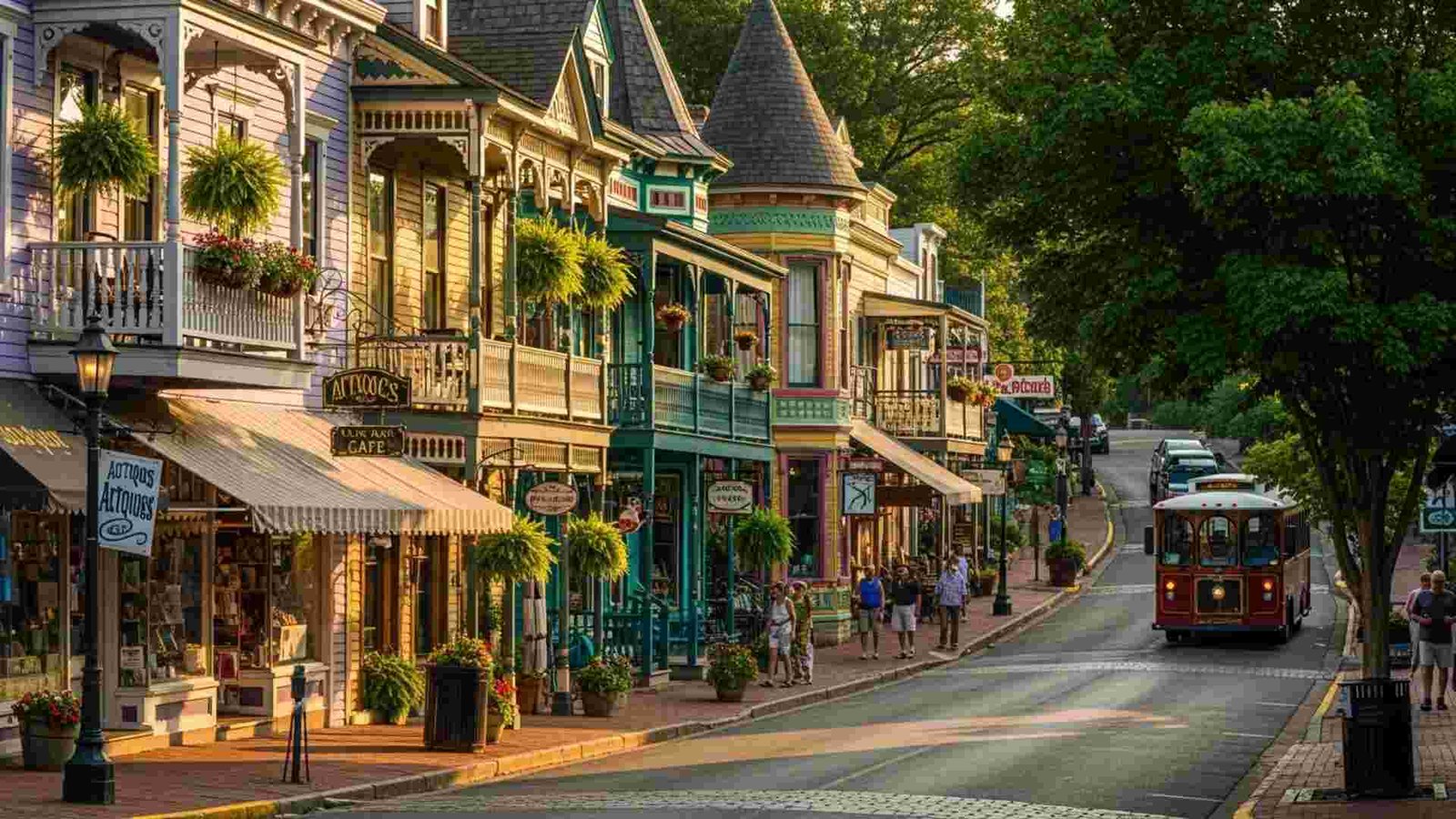
Perched on winding Ozark hillsides, Eureka Springs feels like a fairytale built in layers. Every Victorian porch seems to cling to the limestone, every staircase leads somewhere unexpected. The town is entirely listed on the National Register of Historic Places, making it one of the most architecturally preserved small towns in America.
Beyond its quirky streets and boutique hotels, the soul of Eureka Springs lies in its craftsmanship and spirituality. Artists, healers, and musicians give this mountain enclave a gentle bohemian heartbeat. Visit Thorncrown Chapel — a glass sanctuary that blends forest and faith — or the local studios hidden behind narrow alleys. Nights hum with live Ozark music, not noise.
Practical Information:
- Peak Season: March–May and September–October for mild temps and festivals.
- Getting There: Drive from Fayetteville (~1.5 hrs).
- Ideal Stay: 2–3 days to cover historic core, art galleries, and nature walks.
- Must-Try: Tram tours, healing springs walk, and Thorncrown Chapel at sunrise.
- Budget Tip: Stay at a locally run B&B; weekdays are quieter and cheaper.
- Cultural Etiquette: Chapels and springs are sacred — keep voices low, dress modestly.
- Photography: Spring Street staircases, Chapel reflections, and autumn foliage.
8. Marietta, Ohio
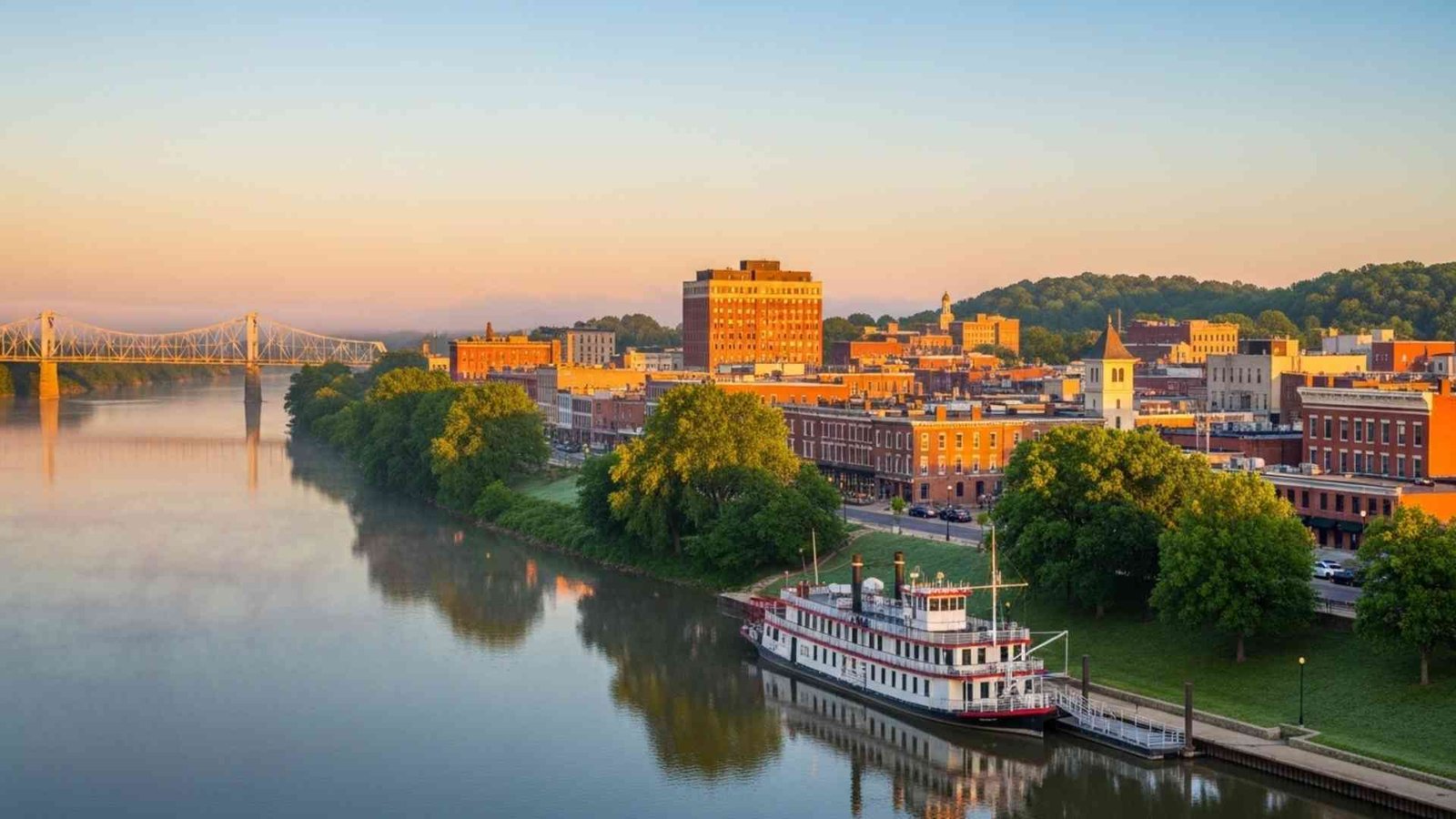
At the confluence of the Ohio and Muskingum rivers, Marietta carries the calm confidence of being Ohio’s oldest city (founded 1788). Main Street flows like the river beside it — steady, friendly, lined with brick buildings that remember steamboat days.
The town comes alive every September during the Ohio River Sternwheel Festival, when a fleet of vintage paddleboats and tens of thousands of visitors turn the levee into a carnival. Outside the festival, it’s quieter — walking trails, antique shops, and river sunsets. History lovers can trace Revolutionary-era graves or tour the Campus Martius Museum to feel where Ohio began.
Practical Information:
- Peak Season: Early September (Sternwheel Festival).
- Off-Peak: April–May and late fall — serene and budget-friendly.
- Getting There: Drive 2 hrs from Columbus or Pittsburgh.
- Ideal Stay: 1–2 days for downtown, museums, and riverside walks.
- Must-Try: Sternwheel Festival, Lafayette Hotel stay, and local BBQ on the riverbank.
- Budget Tip: Book early for festivals — rates double that weekend.
- Photography: Dusk shots of the confluence and paddlewheel reflections.
9. Taos, New Mexico
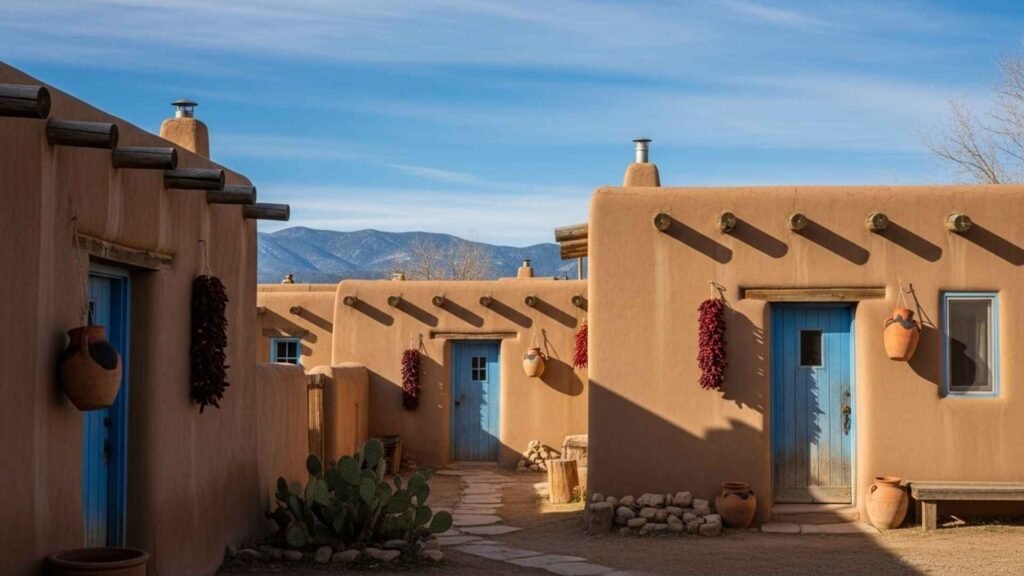
Taos sits under a massive sky that changes color by the minute. At its center is Taos Pueblo, a UNESCO World Heritage site that’s been continuously inhabited for around 1,000 years. That alone gives the town gravity — but it’s also an art capital, with more galleries per capita than most big cities.
The vibe is creative and spiritual at once: adobe walls, desert light, chile aromas, and locals who still speak Tiwa. Pair mornings at the Pueblo with afternoons along the Rio Grande Gorge or in Georgia O’Keeffe-inspired studios. Visit slowly — this isn’t a town you rush through.
Practical Information:
- Peak Season: September–October (fall colors and art festivals).
- Getting There: 2.5 hr drive from Albuquerque or 1.5 hr from Santa Fe.
- Ideal Stay: 2–3 days to balance art, nature, and history.
- Must-Try: Pueblo visit (check closure dates), Taos Plaza, Rio Grande Bridge.
- Budget Tip: Shoulder seasons mean 30 % cheaper inns.
- Cultural Etiquette: Always ask before taking photos at the Pueblo.
- Photography: Sunrise on adobe walls; sunset over the Sangre de Cristos.
10. Hood River, Oregon
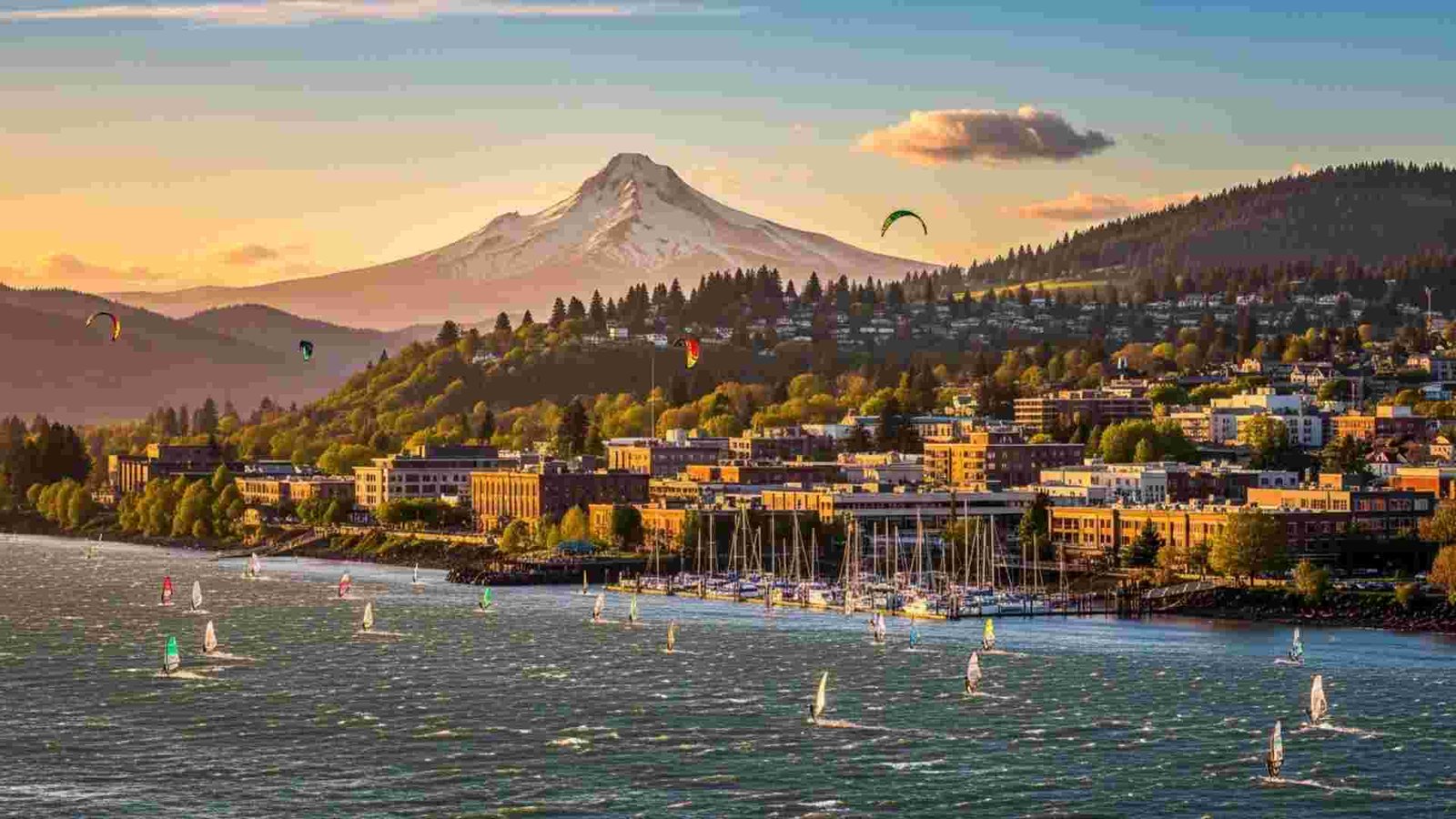
Hood River doesn’t need polish — nature did that already. The Columbia River churns below, Mt. Hood gleams above, and the valley between bursts with orchards and vines. Known as the Windsurfing Capital of the World, it’s also Oregon’s quiet farm-to-table heartland.
Beyond the adrenaline and Instagram shots, locals love the rhythm of harvest: cycling the 38-mile Fruit Loop, sampling pear cider, and watching kiteboarders carve across the Gorge. You can ski Mt. Hood in the morning and sip local pinot noir by evening — it’s that kind of place.
Practical Information:
- Peak Season: August–October (harvest & ideal weather).
- Off-Peak: May–June for waterfalls and wildflowers.
- Getting There: 1 hr drive east from Portland via I-84.
- Ideal Stay: 2 nights minimum to explore town + Fruit Loop.
- Must-Try: Cider tasting, Columbia Gorge hikes, and brewery hopping.
- Budget Tip: Visit midweek — less traffic, cheaper rentals.
- Cultural Etiquette: Respect orchard property; ask before entering private farm rows.
- Photography: Mt. Hood over orchards, kite sails against the cliffs, and twilight by the marina.
11. Brevard, North Carolina
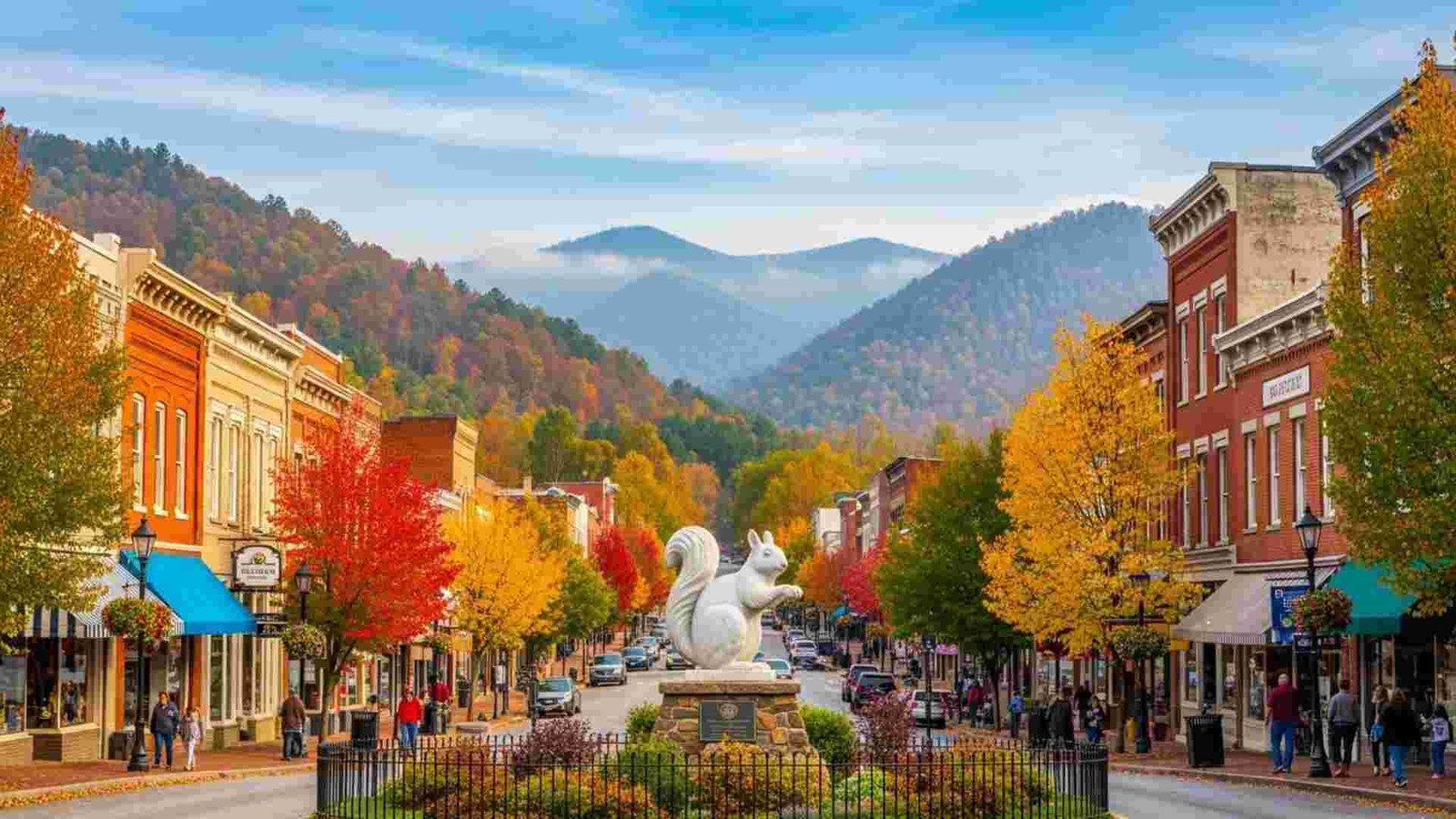
Water does the storytelling here. Trails slip past ferny hollows to falls with names that sound like chapters—Looking Glass, Sliding Rock, Whitewater. Transylvania County isn’t coy about it either: there are ~250 waterfalls within reach, which is why Brevard keeps topping regional “adventure town” lists. When the heat rises elsewhere, locals head for the mist.
pair a morning waterfall loop in Pisgah National Forest with an unhurried evening on the lawn at the Brevard Music Center—symphony one night, bluegrass the next. The summer institute brings hundreds of students and a season that typically runs late-June to early-August, turning this small town into a music campus under the stars. Here’s what I mean: sneakers at noon, sundress by eight.
Practical Information:
- Best window: late May–Oct (full waterfall access; summer concert season).
- Micro-itinerary: AM Looking Glass/Sliding Rock > downtown lunch > PM BMC concert.
- How long: 2–3 days. Drive time: ~45 min from Asheville.
- Pro moves: check parking pages before downtown; buy BMC tickets in advance. Photo cue: early light on Looking Glass Falls; blue hour at Parker Concert Hall.
12. Stillwater, Minnesota

Old river town, new rhythm. The historic Lift Bridge—now for pedestrians—becomes your front porch over the St. Croix; couples linger for sunset as paddlers ghost below. Main Street is all brick, bookstores, and bakery smells, but the water sets the pace.
cross the bridge and stroll the looped ped/bike trail to watch the lift span cycle, then angle back for a patio table where you can hear the gears clack faintly across the water. In fall, Stillwater leans cinematic—leaf colors crowd the bluffs and the old grain elevators glow.
Practical Information:
- When: Sep–Oct for foliage; Jan–Feb for quiet river walks and snowy rooftops.
- Move around: Park once and walk the riverfront + bridge loop.
- Stay: 1–2 nights. From MSP: ~30–40 min drive.
- Try this: lift-bridge sunrise, antique hunt by late morning, St. Croix boat cruise before dinner.
- Photo tip: telephoto details of the truss; dusk reflections from the Wisconsin side.
13. Bisbee, Arizona
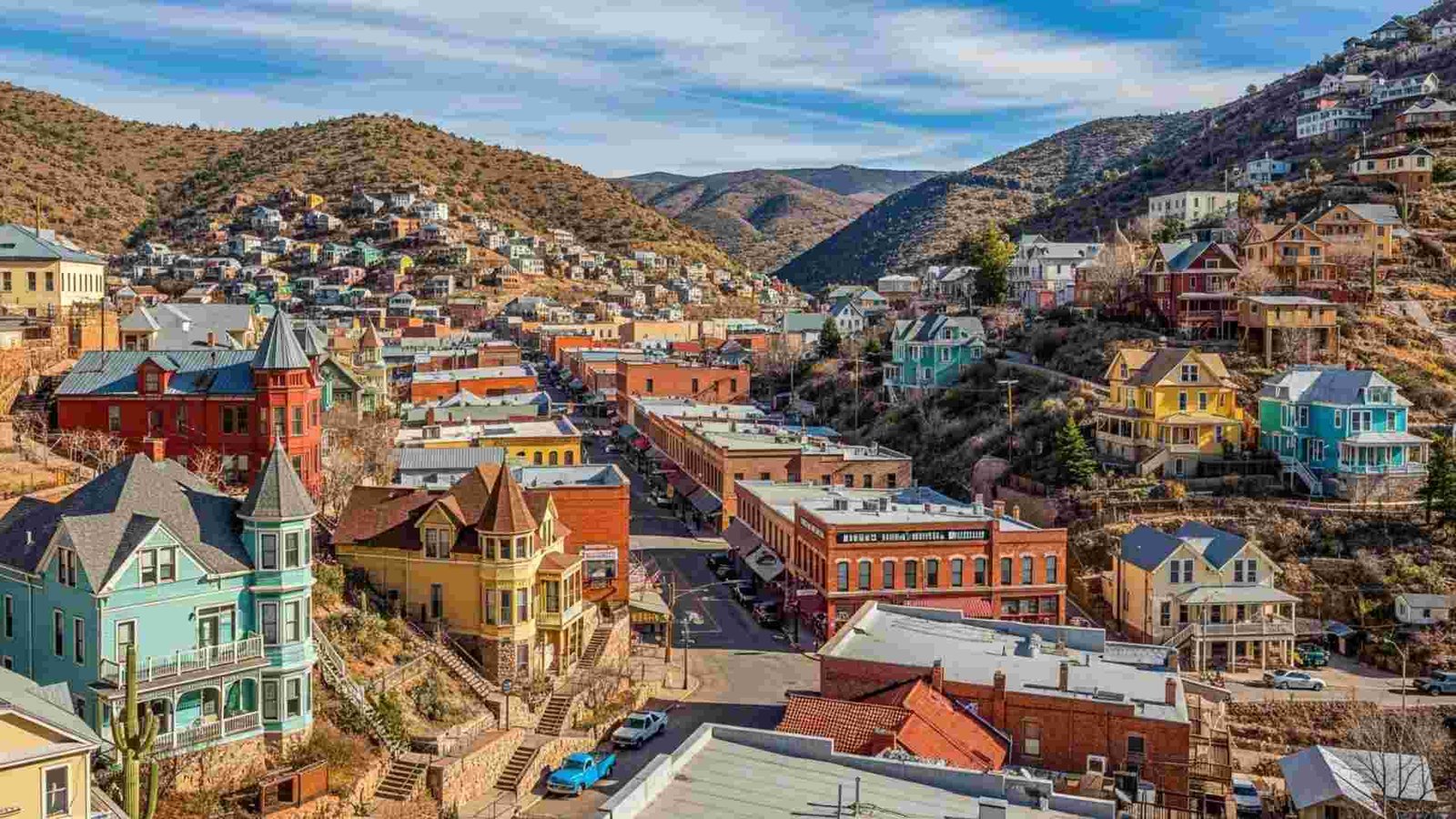
Copper town turned artists’ aerie, stacked in sun-baked switchbacks. Start underground: the Queen Mine Tour pulls on hardhats and rattles you by rail into the cool dark—docents are retired miners with stories that stick. Back outside, alleys bloom with murals and staircases go everywhere.
the Bisbee 1000. Nine stairways, ~1,000+ steps, a 4.5-mile roller of neighborhood views—locals train on it year-round. Even if you’re not racing, walking two or three flights nets secret pocket gardens and porch-cat encounters. You’ll feel it tomorrow. In a good way.
Practical Information:
- Best months: Oct–Apr (dry, cool). Altitude: ~5,300 ft—hydrate.
- Don’t miss: miner-led Queen Mine (book prime slots), stair-crawl at golden hour, brewery courtyard at night.
- Plan: 1–2 nights; combine with Tombstone or Chiricahuas.
- Photo notes: color-washed adobes, hand-painted stair risers, tunnel-to-daylight shot from the mine exit.
14. Hermann, Missouri

Germany by river light. Vines stripe the hills, church spires mark the skyline, and the station sits a short walk from tasting rooms—yes, you can arrive by Amtrak’s Missouri River Runner and skip the car entirely. Weekends hum with accordions, pretzel braids, and clinking glasses.
this is foundational U.S. wine country. The region helped pioneer American viticulture; today you can trace it glass by glass on the Hermann Wine Trail (seven member wineries, a few over 100 years old). Time it right and slide into Maifest or Oktoberfest—street bands, sausages, and cellar tours that run long.
Practical Information:
- Car-free combo: train in > roll bag to inn > walk the hill to tastings.
- Varietals to ask for: Norton, Vignoles, Chardonel.
- Stay: 1–2 nights; book festival weekends months ahead.
- Photo cue: sunset from a hilltop pergola; Amtrak arrival with vine-covered bluffs behind.
15. Lititz, Pennsylvania
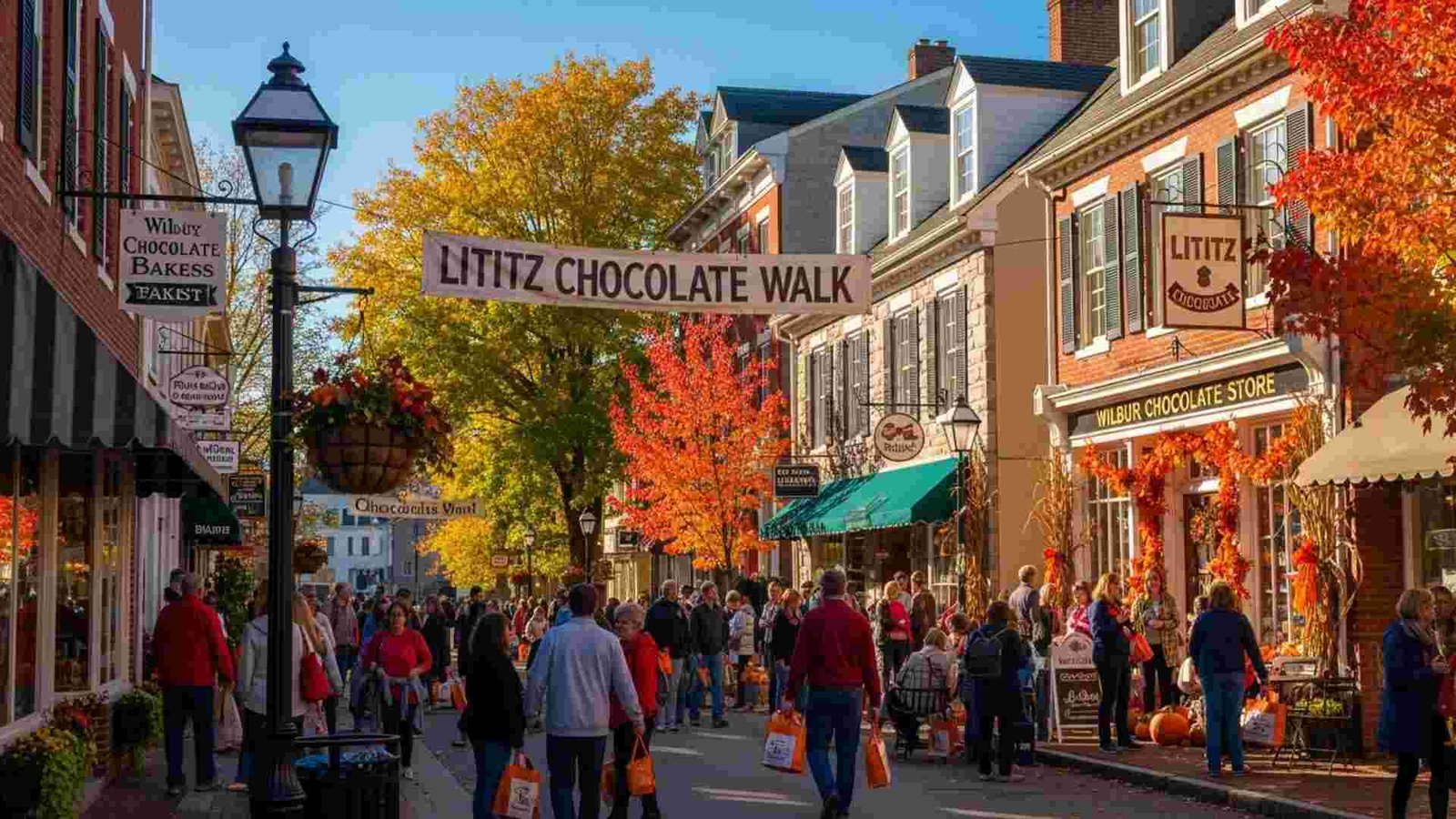
Craft town with a sweet tooth. Step from the Julius Sturgis Pretzel Bakery—founded 1861, first commercial pretzel bakery in the U.S.—to the cocoa-scented world of Wilbur Chocolate and its museum. Add a leafy saunter through Lititz Springs Park and you’ll get why it was crowned “America’s Coolest Small Town” a while back; the vibe stuck.
ask about twisting your own pretzel on the short tour (kids light up), then detour into the Moravian historic district for quiet stonework and tidy gardens. It’s a town built for strolling and nibbling—small-batch coffee, flaky pastries, and those iconic Wilbur Buds for the ride home.
Practical Information:
- When: spring blooms, December lights, or any Saturday market day.
- How long: 4–8 hours (easy day trip from Philly/Baltimore).
- Do this: pretzel-twist class > Wilbur museum > park picnic.
- Photo tip: storefront signage, pretzel-twist closeups, creek reflections in Lititz Springs Park.
16. Ely, Nevada

Desert edges, dark skies, and steam whistles at night. The Nevada Northern Railway runs heritage trains straight into stargazing country; book the Great Basin Star Train and astronomers help you read the sky under some of the darkest lower-48 heavens. It’s goosebump stuff—the Milky Way looks poured on.
daytime at Great Basin National Park (Lehman Caves, bristlecone pines), dinner back in town, then the Star Train roll-out. Think about it this way: few places hand you deep time (fossil seas, ancient trees) and deep space in one weekend.
Practical Information:
- When: June–Sept for Star Train (limited dates; sell out fast).
- Plan: 2 nights—park day + rail night. Drive: ~4 hrs from SLC / ~4.5 from Vegas.
- Bring: layers (high-desert nights), tripod, wide-angle lens.
- Photo cue: locomotive under a star-crowded sky; Lehman stalactites at slow shutter.
Conclusion:
From river towns with brick-and-butterfly evenings to mountain villages that wake with church bells and trail dust, these places trade hype for heart. You get real storefronts, family recipes, and festivals that still feel local. Pick your season—foliage, harvest, snow, or spring bloom—and plan slow so you can wander, talk to shopkeepers, and linger at sunset. The coasts can wait; America’s small-town main streets are where the getaway story gets good.


